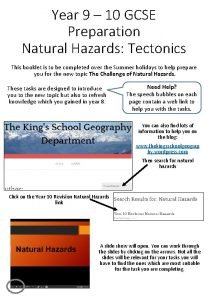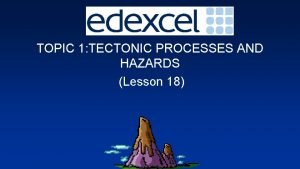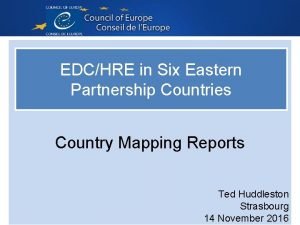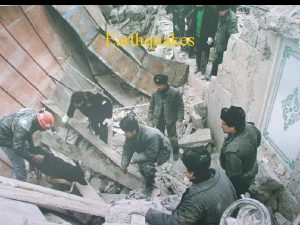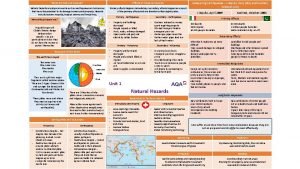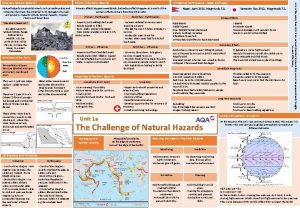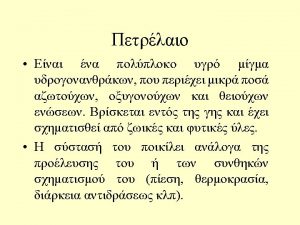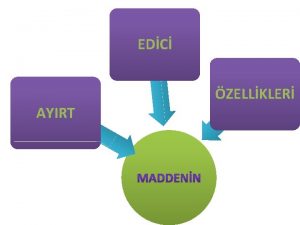Unit 1 Hazards Climatic Tectonic EDC Climatic Hazard






- Slides: 6


Unit 1 Hazards (Climatic & Tectonic) EDC Climatic Hazard: Typhoon Haiyan 2013 AC Climatic Hazard: UK Drought 2012 LIDC Tectonic Hazard: Haiti Earthquake 2010 Location and background • Philippines is located in South East Asia • It is an archipelago of over 7000 islands • Its population is almost 100 million • GNI per capita is $3470 • Over half the population lives in rural areas • Typhoon Haiyan struck the city of Tacloban in November 2013 It was a category 5 Typhoon Location and background • Most of England was in drought in 2012 • Central and South-eastern England worst Affected • Between April 2010 – May 2012 parts of England received 55%-85% of normal rainfall Causes Typhoon Haiyan formed as an area of low pressure in the Pacific Ocean at a latitude of 7 degrees North. The conditions were right for its development into a Typhoon: • Sea temperature was above 26. 5 o. C, ocean depth over 60 metres • The Coriolis effect at this latitude was able to start the storm clouds spinning. It moved westward due to the trade winds towards Philippines, gathering strength from evaporation • It reached Tacloban on 7 November 2013. Wind speeds peaked at 315 km/hour with driving heavy rain • The low air pressure and strong winds caused sea levels to rise, causing a storm surge of up to 6 metres, reaching 1 km inland in Tacloban – a densely populated area Causes Less rain: Unusual wind patterns brought dry winds from Europe in the east rather than the usual wet westerly prevailing wind Warmer temperatures: Warmer than usual weather led to more evaporation from reservoirs, soil and rivers Dry soils: It was difficult for any rain that did fall to infiltrate into the ground as the soil was dry and baked hard High water usage: People in the UK use around 165 litres of water a day each. Massive amounts are also used by industry and farming. This amounts to 1. 7 billion litres per day. Up to a third of water is also lost due to leaky pipes. In warm weather, people’s water use increases even more due to additional showers and watering the garden. Causes • Haiti lies on a transform plate boundary between the North American and Caribbean plates • Pressure builds up over time as the plates slide past each other. When this pressure is released suddenly in a fault, seismic waves are released causing shaking at the earth’s surface • The 7. 0 magnitude earthquake, which struck on 12 th January 2010 had a shallow focus (7 km under the surface)and its epicentre was very close to the capital city – port-au-prince. • Many of the buildings in the city were build to poor standards and many of the slums were built on unstable land, so collapsed easily. Powerful aftershocks caused further damage and killed and injured survivors searching in the rubble Primary Consequences • Crops were damaged – this led to long-term shortages of food • Buildings were damaged by strong winds, trees uprooted and infrastructure damaged - $2. 86 Billion of damage • 6300 people were killed, often by drowning others were injured by falling debris • Damage to 571 clinics and hospitals – meaning the injured were unable to access medical treatment Secondary Consequences • people living in Tacloban all knew someone who was killed • Around three quarters of farmers/fisherman lost their income • 85, 000 litres of oil leaked into the sea from a punctured barge contaminating marine ecosystems and food sources • 500, 000 people were made homeless, without clean water , sanitation or food – this led to the spread of diseases like Cholera Consequences • Farming: Water shortages made it diffuclt to find water for crops and livestock, reducing yield and farmers’ incomes. The dry ground also made it difficult to harvest crops in the autumn of 2011 • Environment: Dry areas of moorland caught fire easily – wild fires raged over parts of South Wales, Surrey and the Scottish Borders. River water was used to boost the water supply, reducing river levels and affecting river ecosystems damaging plants and animals • Restrictions on homes: Hosepipe bans meant that 20 million people weren’t allowed to use hosepipes to water gardens or wash cars Primary Consequences • Buildings and infrastructure were damaged or destroyed - costing $11. 5 billion • 230, 000 people were killed, mostly in collapsed buildings • 180, 000 homes destroyed – leaving people without shelter Secondary Consequences • 5000 schools were destroyed so children were unable to access education • The government and police lost control leading to a breakdown of civil society • 500 inmates escaped from the prison endangering vulnerable people • The economy came to a standstill, most people were unemployed and many turned to crime • The 1. 5 million homeless people set up 1100 temporary camps, with limited clean water , sanitation or food – this led to the spread of diseases like Cholera killing hundreds. Responses: Emergency (short-term) aid • UN sent £ 190 million – food assistance to 4 million people and emergency shelters for 500, 000 people • Many countries sent bi-lateral aid – Australia spent $28 million on providing medical staff, water containers and hygiene kits • BUT: aid efforts were made difficult because the airport had been destroyed and there was looting and crime. Social media was used to ask for volunteers Responses: Long term Development aid • Aid agencies and the government repaired infrastructure, getting many schools and hospitals back open by April 2014 • 1500 km of roads were repaired • Cash was given for training to support small businesses and to create employment • Mangroves were replanted to defend the coast against future storms Responses • Water transfer schemes to move water from areas of suprlus to areas of deficit – e. g. from Norfolk to Essex (the UK’s driest county) • Permits granted for extraction of additional water from rivers & groundwater to refill reservoirs • Hosepipe bans to reduce water use, thereby conserving the water supply • Campaigns to get people to use less water e. g. turning off taps whilst brushing teeth can save 6 litres per minute • Water companies spent extra money fixing leaky pipes • Thames Water have provided (for free) ‘save a flush’ bags for toilet cisterns saving water on every flush. The have also issued ‘slow flow’ devices for shower heads to reduce the water flow rate to save water Responses: Emergency (short-term) aid • Local people made up most of the initial search and rescue, with limited equipment. Later the USA and Dominican Republic sent food, water, medical supplies and shelter. They also sent medics, sniffer dogs and heat sensors to search for survivors • The UN provided security to ensure fair distribution of aid and for safety • The UK provided £ 100 million for shelter, medicine and sanitation Responses: Long term Development aid • The world bank has provided $100 million to support reconstruction and recovery in Haiti • ¾ of damaged buildings have been inspected and repaired • Jobs have been created doing public work like clearing rubble • Thousands of homeless have migrated out of Port-au-Prince to live with family BUT: aid efforts were hampered because the port was badly damaged. Aid did not arrive in sufficient quantity for weeks meaning many injured did not get help, raising the death toll. The lack of law and order and blocked roads made distributing aid difficult. Over time reservoir levels fell leading to water Shortages. Location and background • Haiti shares an island with the Dominican Republic, in the Caribbean Sea • It is situated near a boundary between The Caribbean plate and the North American plate Haiti is an LIDC. Before the earthquake It had one of the lowest standards of living In the world. Buildings were poorly Constructed and the country unprepared.

Unit 3 Distinctive Landscapes Location The Thames Basin is located in the South East of England. The Thames is England’s longest river, at 346 km from source to mouth. With 13 million people living in its basin, it is the most densely populated river basin in the UK. Geomorphic Processes Rainfall Although rainfall levels in the Thames basin are generally not excessive, occasionally there can be winter storms from the Atlantic like the one in February 2014. Between 1 Dec 2013 and 19 th Feb 2014 487 mm of rain fell, more than 200% of the usual amount. The ground became saturated and water levels in the Thames were very high. This caused the worst flooding along the river in 40 years – 5000 homes and businesses were flooded in and around Staines. High volumes of rainfall increase the volume of water carried in the river. This gives the river more energy to carry sediment (transport) and erode it banks/bed by abrasion & hydraulic action. Temperature Extremes of cold can freeze the ground in the basin making it impermeable. Equally warm dry weather can bake open soil into a hard crust making it quite impermeable. When ground is impermeable there is less infiltration of rainfall and more overland flow, increasing the risk of flooding. River Terraces in the Thames Valley Meanders near Oxford Geology The Thames’ source is in the Cotswolds Hills, which consist of Jurassic Limestone. It flows eastwards, through a gap in the Permeable Chilterns Chalk at Goring (the Goring gap). For the remainder of its journey it flows over impermeable London Clay to the North Sea. London gets 40% of its water supply from groundwater. Boreholes are drilled through the clay to reach the porous Chalk aquifers underneath. The Thames is a lowland river (its source is only 108 metres above sea level) , and has a gentle gradient throughout its course. Therefore there are no upland features like waterfalls or rapids. Because it is a lowland river there is little gravitational potential energy, meaning there is little vertical erosion. Due to the large volume of water carried there is lateral erosion. This forms meanders (e. g. near Oxford). Meanders are eroded on the outside of the bend, whilst deposition takes place on the inside of the bend. This is due to the fastest flow being on the outside of the bend, giving the water Landforms more energy for erosion by abrasion & Geology and hydraulic action. UK River Landscape Case Study: The Thames Basin Human impact in the Basin The Thames Basin is heavily deforested for farming and urban areas. This reduced tree cover means that there is less interception of rainfall and more soil erosion. Less interception means more surface runoff, increasing the chance of flooding. Soil erosion causes sedimentation in the river, reducing its capacity, increasing the chance of flooding. The high % of urban land use means lots of man made impermeable surfaces and drainage, increasing surface runoff and the risk of flooding. Soft engineering: Flood abatement In Twickenham, land has been zoned near to the river to be parkland (Radnor Gardens) or Car Parks. This allows place s for the Thames to naturally flood with minimal long term impact, protecting other places of higher land value like shops, offices and homes. The Thames has followed the same course for the last 500, 000 years. In that time we have seen several ice ages , leading to changes in sea levels. Each time the sea level falls the river is given more energy to erode down into its valley (to reach the new sea level). This process is called REJUVENATION. When sea level later rose the river lost energy and deposited sediment creating a new floodplain. Over time this created a ‘stepped valley’ called river terraces (see diagram). River Management & Human Impact Hard engineering: Jubliee River An artificial river know as a diversion channel was created in 2002 called the Jubilee river. Its purpose was to divert surplus water from the main Thames channel before Maidenhead, returning the water to the Thames at Staines. The river takes a shorter route taking flood water away from the area more quickly. This reduces the risk of flooding at Maidenhead, Windsor and Eton, but increases the flood risk further downstream, for example at Staines. There are future plans for a £ 500 million flood relief channel extending to Teddington, to protect all areas west of London Hard engineering: Thames Barrier The Thames is a tidal river. High tides (particularly when combined with low pressure storms in the North Sea) cause surges of sea water to be funneled up the Thames estuary into central London. This has the potential to cause extensive flooding in high value parts of the city, which are built on the low lying land of the Thames floodplain. The Thames Barrier can be raised to block this incoming surge, preventing water from backing up the Thames and bursting its banks. During the Winter Storms on 2013/14 the barrier was shut more than 50 times – the most ever!

Unit 4 Sustaining Ecosystems Location Antarctica is a continent at the south pole, surrounded by the Southern Ocean. Antarctica is the worlds 6 th largest continent. It is also on average the highest and coldest. Most of the continent is covered by an enormous ice sheet (approximately 90% of the world’s ice is here) and only 2% of land is exposed at the top of mountains or on the coast. This means there are few places for plant life to establish. Union Glacier is located in West Antarctica, just south of the Ronne ice shelf and situated in the Ellsworth range of the Transantarctic mountains. Small Scale Sustainable Management: Union Glacier tourism, Adventure Network International Global Sustainable Management: The Antarctic Union Glacier is a temporary logistics hub camp set up In the summer months to as a base for tourism. It is operated by Adventure Network International (ANI). Treaty 1959 and the Environmental Protocol 1998 The Antarctic Treaty was agreed by 12 countries in 1959 about how to protect Antarctica's ecosystems and came into force in 1961, today 52 countries have signed. The treaty states: • No military bases or weapons testing • No nuclear explosions or nuclear waste disposal • No country may lay claim to territory • Countries must cooperate and share scientific research Large & Small Scale Sustainable management of polar areas: Antarctica ANI must abide by strict rules agreed by all tour operators. to protect the environment and minimise the impact of the tourists. These rules are based on Antarctic Treaty protocols. The Environmental Protocol 1998 sets out a further 6 principles: • No mineral exploitation allowed (e. g. mining) for 50 years • A ban on killing or interfering with wildlife (no dogs can be brought to Antarctica) • All waste must be removed – no dumping or burning of rubbish • Fishing in the Southern Ocean is highly restricted • All activities must be assesed for their likely impact on the environment before they are allowed The treaty has been successful at protecting environment of the continent so far, the environment is still pristine and one of the few places on earth where human impact has been minimised. It remains dedicated to peace and science. However, some people believe the treaty should be extended to included more protection for the ocean surrounding Antarctica to protect marine life. Some aspects, like the ban on mining expire after 50 years - what will happen then? Also the treaty can’t protect Antarctica from the effects of global climate change. Some parts of Antarctica are experiencing warming and loss of ice. While every effort is made to minimise the impact of tourist arrivals to Antarctica, most visitors will travel by boat or plane. Tourist cruises dump large amounts of grey and black water (waste water) into the Southern Ocean. They also leak diesel fuel. Air travel is a large contributor to global climate change, warming the continent. It is difficult to ensure all tourists do not leave any waste or bring contaminants onto the continent in their clothing/shoes.

Unit 4 Sustaining Ecosystems Location Deforestation Costa Rica is located in Central America, straddling the Pacific Ocean to its west and the Caribbean Sea to its east. Its rainforest is only 1/100 th of the size of the Amazon yet still contains 6% of all of the world’s biodiversity and attracts 2 million tourists per year. Background In the 1960 s Costa Rica began to experience rapid deforestation, mainly due to cattle ranching and agricultural development. Between 1970 and 1990 Costa Rica had one of the highest rates of deforestation in the world, reaching its peak in 1985 with 32, 000 hectares of forest lost per year (1. 4% of the total) Sustainable management Mesoamerican Biological Corridor Costa Rica, together with neighbouring Central American countries, is trying to create a continuous wildlife corridor along the length of Central America from Mexico to Panama. It’s called the Mesoamerican Biological Corridor. The aim is to reconnect fragments of rainforest to provide routes forest animals to migrate rather than be trapped in isolated pockets of forest. Recognising the problem of deforestation, the government passed laws to stop deforestation. These have been successful – deforestation has declined to almost zero! 1) 2) 3) They created 28 National Parks and nature reserves , meaning 24% of the country’s land area is protected. Landowners are paid to keep their land as forest rather than converting it into farmland Farmers are encouraged to do agro-forestry, where trees and crops are grown together. Crops benefit from the shelter of the canopy and nutrients from falling leaf litter. Soil erosion is reduced and biodiversity supported. Afforestation: Trees are planted to replace the original primary forest that has been lost. However this secondary forest lacks the biodiversity of the primary forest as it takes a long time for species to re-establish. Sustainable Management: Options Sustainable management of the Tropical Rainforest: Costa Rica Ecotourism Actions of the CR government Selective Logging: Trees are felled only when they reach a certain height. Young trees are allowed to mature to ensure that the height of the canopy is maintained. Ecotourism is a type of sustainable development that aims to create local employment while conserving the natural environment. However, ecotourism still brings people to remote environmentally sensitive places, putting pressure on sewerage and water supplies. To get there tourists usually fly and consume fossil fuels, creating pollution. Economically Sustainable Samasati eco resort uses locally sourced timber from an afforestation project. They employ local people for most jobs, reducing the need for people to work in industries that cause damage to forest areas and any money and profit made stays in the local community and can be reinvested. Monitoring: Satellite technology and photos are used to ensure that no illegal activities are taking place and that landowners follow guidelines for sustainability. Sustainable Development of the rainforest: Local scale, Samasati Nature Retreat Socially Sustainable The resort consults and involved the local community in its development. Local people and schools are encouraged to make use of their facilities and they run an education programme about sustainable development and protecting the environment. Taxes paid locally go into improving local services and infrastucture. Environmentally Sustainable Natural light and ventilation minimise energy use. Samasati resort uses a nearby stream for renewable energy. All detergents/cleaners are made from natural biodegradable ingredients Rainwater is collected from the roof for showers and flushing the toilet. The resort is small scale to limit its impact and buildings are designed to blend in the natural environment. Sustainable Development: economic, social and environmental development to meet people’s needs now without compromising the ability of future generations to meet their needs. Sustainable management: Using resources carefully so that future generations can also use them to meet their needs.

